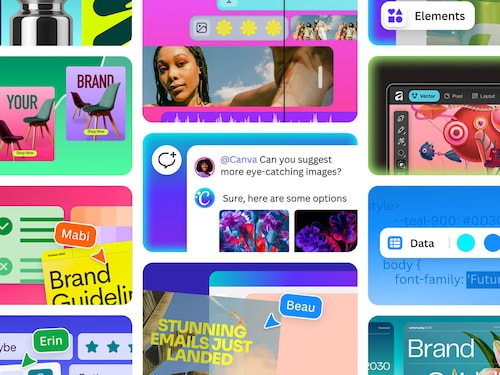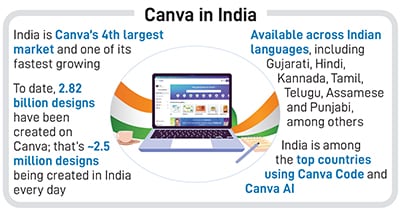How India’s ‘Good morning’ WhatsApp culture is fuelling Canva’s growth
Unveiling a new suite of AI-powered tools, Canva’s leadership speaks about how India, their 4th largest market, is at the centre of their global strategy


Canva is dabbling in a new era, of imaginative design that goes beyond its graphic design DNA.
The Australian platform, often credited for democratising digital design with its intuitive drag-and-drop interface, has unveiled a series of AI-powered tools that can be used to better design email, spreadsheets, video editing and advertisements, along with an AI assistant and coding facilities that let you design a functioning website right from its toolbox. And India, its fourth largest user base, is at the centre of its global strategy.
In fact, in September this year, Canva made a surprising Rs 544.48 crore bid to become the main jersey sponsor of the Indian cricket team—second only to Apollo Tyres’s Rs 579 crore winning bid.
“India is today the fourth largest market for Canva. There's no reason why it should not be the largest,” Chandrika Deb, country manager for Canva in India, told Forbes India. “We are looking for various opportunities that can help us build deeper relationships with our community and will continue to invest heavily in India, with the goal of reaching every Internet user.”
Edited excerpts from a conversation with Deb and Canva’s global head of product, Robert Kawalsky, on the company’s fast-paced growth in the country, and where it features in their global strategy:
Q. With new tools for email, forms and spreadsheets, Canva is moving away from just graphic design into a full stack of workflow tools. What’s the strategy behind this
Kawalsky: Our vision has been really consistent over the years. We think that everyone is truly a creative, and we’re looking to unlock that creativity. The breadth of our suite, you’re absolutely right, has expanded massively. We have found that our community really looks for this inter-operability between tools. We want Canva to lie at the intersection of creativity and productivity, that’s where the magic of work happens.
Q. India is Canva’s fourth-largest market. What factors do you think make Canva so popular in India?
Deb: India is not just one of our largest markets in terms of the users, but also one of our fastest-growing—we have steadily been growing at a strong double-digit growth year-on-year over the last three years. We have about 2.8 billion designs that have been made from Indian users—that’s about 2.5 million designs that are being created in India every day.
We've been doing a lot of work on localising our product for India—a majority of Indian users are mobile users, for instance, so our product has to cater to that audience. Similarly in terms of content, we have invested a lot in understanding what users in India want to create content on, not just looking at languages—we have Canva available in 13 Indian languages—but taking it a step further to see what they are searching for.
This includes ‘good morning’ messages that you receive on social media, or greetings for festivals, which are a really big phenomenon in India, or unique Indian occasions like annaprashan or grihapravesh. Or, take weddings. They are really big in India, but a wedding in Tamil Nadu is very different from one in Punjab or West Bengal, so we work on creating that variety in content to understand cultural nuances and build our product that way.
Q. What are some of the sectors or user communities that are driving the growth
Deb: In the first decade of our existence, our Indian user base was more individual users. Now we have started focusing on empowering organisations, and we are seeing that a lot more professionals are using Canva Code, one of our AI-powered features that lets users create interactive experiences through simple prompts. That's where our biggest growth is coming from, and India is one of the biggest adopters of Canva’s AI features.
Kawalsky: It’s really exciting to me that India is actually the top country using Canva Code and Canva AI. And I think that really speaks to just how forward thinking our Indian community is in leveraging these tools to get their work done.
India is a huge source of inspiration for us for where ultimately everyone's going—because India’s actually kind of got there first.new
Deb: We are also building strong partnerships with people in the design and education ecosystems. We are working with NCERT to launch a teacher certification course on design thinking and visual communication. Plus, we see a huge adoption of Canva Code among teachers.
SMBs are a big area of focus for us—a lot of small businesses use Canva to build their brands, whether it is through social media content or making branding assets. Besides, we work with 500+ creators in India who are helping us co-create our content and also using the platform to grow their social presence and building their brand. A lot of these are bespoke strategies to localise the Canva brand specifically for India.
Q. India has always been a price-sensitive market. How does the pricing strategy work here versus other countries?
Deb: The pricing strategy for India is very different versus other markets. What we are trying to do is to see how we can make pricing not just affordable, but also easy for Indian users. The first step is how do we make payments affordable for Indian users. The one-day, one-week sachet pricing is something we launched in India first and has now been taken globally to a lot of other similar price-sensitive markets. The idea was to enable users in India to overcome the barrier they have about price, give them an opportunity to try the product, engage with it and then become a long-term user when they see value.
Apart from that, we are also launching a bunch of other SKUs to see how we can create certain SKUs where we combine some of the premium features and make that more affordable for Indian users. That's something we are planning to launch in the coming months. We are also exploring partnerships—for example, with small businesses that are typically low on resources, we have been doing some community engagements like free trials where we give them coupons or we give them an opportunity to use Canva for a limited period.
Q. What is the role of a professional designer in the age of AI?
Kawalsky: If the question is really about whether AI will replace professional designers—we don’t see that at all actually. We see AI as a mechanism to enhance designers of all levels of experience. So at the consumer end, people can create things that were never possible before. And as you move up the pyramid to professional designers, AI can help iterate and be much more expansive, allowing you to work on multiple things at once. AI is a very powerful mechanism—but it is just a way to enhance creativity.
Q. And how does Canva balance ethics with innovation in this realm?
Kawalsky: Yeah, it's a great question. We have taken a really firm view on this and take that side of the equation really seriously.
First is how we think about training our own models. So we work with a community of creators who have created and continue to create templates for Canva. This content is used to train our models, purely on an opt-in basis. But importantly, they are compensated for being involved in those programmes.
We also have Canva Shield, a full spectrum of safety and privacy tools for businesses using Canva.
We have consistently taken the view that the power of AI needs to be met with responsibility for a number of years, since we have had generative AI in the product.
First Published: Oct 31, 2025, 09:34
Subscribe Now